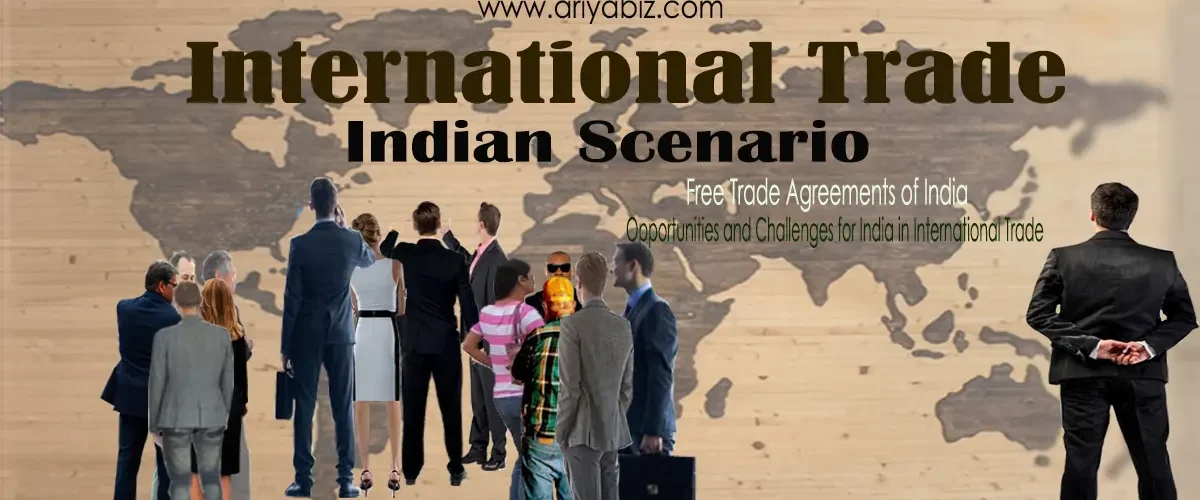International Trade : Indian Scenario

Welcome Readers and Entrepreneurs in the blog post ‘International Trade : Indian Scenario’ where you can explore International Trade, its status, opportunities and challenges for India in International Trade. To read the blog which more fascinating in regional language experience visit
by Google search.
What is International Trade?
As we know in the current era of global economies, international business is crucial. Global trade plays an important role in the world economy. Every Country open up new markets and obtain products and services through international trade that might not be available domestically. The world market is increasingly competitive because of global trade. Every nation has seen a significant increase in international trade. When there is a need or desire for goods or services, capital, goods, and services are exchanged across international borders or territories through international trade. So trade increase nations’ living standards rise due to comparative advantage of trade.
International Trade of India
Here is the information, you require about India’s foreign trade.
India’s global trade in goods, merchandise, and commodities includes exports of goods, services, imports of goods, and imports of commodities also. International Trade of any country is calculated by Balance of Trade (BoT).
In the Case, Balance of Trade (BoT) of any country is calculated by the following formulae:
Balance of Trade (Merchandise or Services) = Export of goods or Services – Import of goods or Services
Since 1980, India has had persistent trade deficits, mostly as a result of a sharp increase in imports, mainly of bituminous materials, mineral fuels, oils, waxes, pearls, precious and semi-precious stones, and jewelry. The countries with the largest trade deficits in recent years were Saudi Arabia, China, Indonesia, Switzerland, and Iraq. At the GDP level, the World Bank’s PPP (Purchasing Power Parity) of the Indian Rupee is currently 20.65.
As Indian Government stats indicate 70% of India’s total exports come from just six states: Gujarat, Maharashtra, Karnataka, Tamil Nadu, Andhra Pradesh, and Uttar Pradesh. Out of which 50 percent of the nation’s merchandise exports are made up of Maharashtra (16.60%) and Gujarat (33.55%) only.
India looks for International Trade in following products:
Agricultural Product, Processed Foods, Dairy Product, Floriculture, Imitation Jewellery, Finished Leather, Leather Footwear, Footwear Components, Leather Garments, Leather Goods, Saddlery & Harness, Non-Leather Footwear, Art metal Wares, Wood wares, Hand printed Textiles & Scarves, Embroidered & Crocheted Goods, Shawls as Art wares, Zari & Zari Goods, Imitation Jewellery, Petroleum Products, Gold and Other Precious Metal Jewellery, Coal, Coke Briquettes, Pearl, Precious, Semiprecious Stones, Electronic Components, Telecom Instruments, Organic Chemicals, Industrial Machinery for Dairy, Iron and Steel, Pearl, Precious, Semiprecious Stones, Drug Formulations, Biologicals, Iron and Steel, Electric Machinery and equipment, Organic Chemicals, RMG Cotton including Accessories, Motor Vehicles/ Cars, Marine Products
As a matter of fact, the Ministry of Commerce and Industry’s (MoCI), Directorate General of Foreign Trade (DGFT) is responsible for promoting and facilitating foreign trade in India. Indian government looking for encouraging “self-reliance” in business and that is why support local companies by removing their obstacles to sell their goods and services both domestically and internationally. India interests in internationally to improve its chances for development. India is looking it will bring together stakeholders from academia, civil society, government, and the private sector to serve as a platform for knowledge-sharing, public-private partnerships, and policy advocacy.
You may like to read
Free Trade Agreements of India
Indian Government is attempting to increase export-oriented domestic manufacturing by negotiating free trade agreements with a number of partners, both bilateral and regional. Especially, these free trade agreements (FTAs) address a broad range of subjects, including reduced tariffs that affect the entire manufacturing and agricultural sectors, regulations governing the trade of services, digital concerns like data localization, intellectual property rights that could affect the availability of pharmaceuticals, and the facilitation, promotion, and protection of investment. FTA partners gain easier market access into each other’s markets by doing away with tariffs and some non-tariff barriers. Because they receive preferential treatment over competitors who are not FTA members, exporters prefer free trade agreements (FTAs) to multilateral trade liberalization.
It will include the three agreements signed in the last five years that are as follows:
- CECPA – India-Mauritius – Comprehensive Economic Cooperation and Partnership Agreement
- CEPA – India-UAE – Comprehensive Partnership Agreement
- IndAus ECTA – India-Australia – Economic Cooperation and Trade Agreement
India has so far ratified thirteen free trade agreements (FTAs) with its trading partners. The following is a list of FTAs that India has signed:
- India – Sri Lanka
- Agreement on South Asian Free Trade Area (SAFTA)- (India, Pakistan, Nepal, Sri Lanka, Bangladesh, Bhutan, the Maldives and Afghanistan)
- India-Nepal Treaty of Trade
- India-Bhutan – Agreement on Trade, Commerce and Transit
- India-Thailand – Early Harvest Scheme (EHS) – FTA
- India-Singapore Comprehensive Economic Cooperation Agreement (CECA)
- India-ASEAN CECA – Trade in Goods, Services and Investment Agreement – (Brunei, Cambodia, Indonesia, Laos, Malaysia, Myanmar, Philippines, Singapore, Thailand and Vietnam)
- India-South – CEPA Korea Comprehensive Economic Partnership Agreement
- India-Japan CEPA
- India-Malaysia CECA
- India-Mauritius – CECPA – Comprehensive Economic Cooperation and Partnership Agreement
- India-UAE CEPA
- India-Australia – ECTA – Economic Cooperation and Trade Agreement
Furthermore, India has signed the following six PTAs (preferential trade agreements):
- Asia Pacific Trade Agreement (APTA)
- Global System of Trade Preferences (GSTP)
- SAARC Preferential Trading Agreement (SAPTA)
- India-Afghanistan PTA
- India-MERCOSUR PTA
- India-Chile PTA
You may like to read
Opportunities and Challenges for India in International Trade
You should know India’s growth rate in international business is more than 8% per year. India possesses abundant resources that surpass those of other countries. India is regarded as the ideal country for business opportunities because of this. It has a strategic location at the hub of the Trans-Indian Ocean routes, which link East Asian and Western European nations.
It will continues to be a popular destination for many international traders. India’s abundance of micro, small, and medium-sized enterprises (MSMEs) can also be leveraged to strengthen ties with leading companies and boost exports. Vietnam, for instance, collaborates closely with international manufacturers like Samsung. Through MSME programs, Indian domestic suppliers increase their capacity for management, productivity, and product supply, strengthening the ties between domestic companies’ supply chains. MSMEs account for about 50% of India’s exports and about 30% of the GDP of the nation.
Challenges and measure for International Trade
India needs to meet quality standards of product
Need to improve institutional support
Improvement of information
Easy access to market
Fund Raising
Improve business networks
Minimize domestic tariffs
Increase of production capacity
Points for Conducting International Trade Business
Learn more about trade statistics, important economic indicators, market opportunities, entry tactics, and other factors businesses should think about before exporting.
Find out about important trade events, industry market overviews, export-import trade data, and sector-based industry trends.
Get the most recent information on trade agreements, product standards, import requirements and documentation, export controls, tariff and non-tariff barriers, and import requirements.
Learn about the most effective approaches to entering new markets through the use of distributors and agents, other sales channels, payment methods and pricing, financing, joint ventures, licensing, and selling to the government.
Learn about local business customs, including attire, business cards, and gifts, as well as visa, travel, and vaccination requirements.
Find out more about the investment climate in the nation.
Trace out Environmental, Political and Economical conditions of country. Learn about the nation’s current relationship with India, local laws, and security and safety advice.
You may like to read
Conclusion and Call to Action
Finally, through the promotion of economic cooperation and the facilitation of cross-border investments, the trade, Business Groups should aims to develop India’s enormous potential. Additionally, Chamber of Commerce and Industry or associations have to build up a special ability to close the gaps between countries by promoting the exchange of best practices, resources, and knowledge to their vast networks and experience. Create a strong and long-lasting link between India and the other countries by promoting cooperation, understanding, and shared interests in development. Chamber of commerce and Industry should for cooperation and communication that could creates personal interests and promotes a common goal for advancement by bringing together a variety of stakeholders, including governments, corporations, and business groups. Keep Reading! Thank You.



